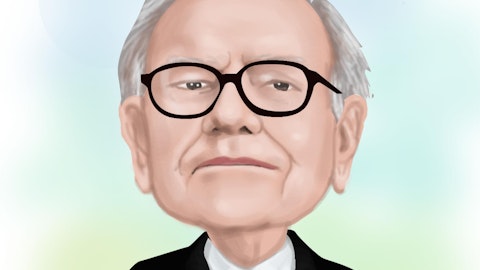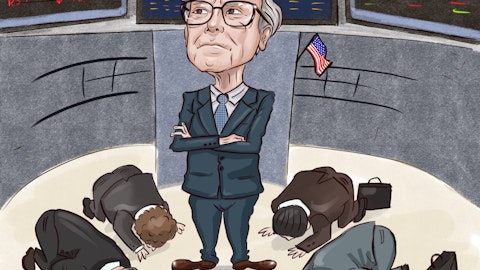D.R. Horton, Inc. (NYSE:DHI) Q4 2023 Earnings Call Transcript November 8, 2023
Operator: Good morning and welcome to the fourth quarter 2023 earnings conference call for D.R. Horton, America’s Builder, the largest builder in the United States. At this time, all participants are in a listen-only mode. A question-and-answer session will follow the formal presentation. [Operator instructions]. I will now turn the call over to Jessica Hansen, Senior Vice President of Communications for D.R. Horton.
Jessica Hansen: Thank you, Tom. And good morning. Welcome to our call to discuss our fourth quarter and fiscal 2023 financial results. Before we get started, today’s call includes forward-looking statements as defined by the Private Securities Litigation Reform Act of 1995. Although D.R. Horton believes any such statements are based on reasonable assumptions, there is no assurance that actual outcomes will not be materially different. All forward-looking statements are based upon information available to D.R. Horton on the date of this conference call, and D.R. Horton does not undertake any obligation to publicly update or revise any forward-looking statements. Additional information about factors that could lead to material changes in performance is contained in D.R. Horton’s annual report on Form 10-K and subsequent reports on Form 10-Q, all of which are filed with the Securities and Exchange Commission.
This morning’s earnings release can be found on our website at investor.drhorton.com and we plan to file our 10-K late next week. After this call, we will post updated investor and supplementary data presentations to our Investor Relations site on the presentations section under News & Events for your reference. Now I will turn the call over to David Auld, our Executive Vice Chair.
David Auld: Thank you, Jessica. And good morning. I am pleased to also be joined on this call by Paul Romanowski, our President and Chief Executive Officer; Mike Murray, our Executive Vice President and Chief Operating Officer; and Bill Wheat, our Executive Vice President and Chief Financial Officer. When we talk about our results, I’d like to congratulate Paul on his well-deserved promotion to CEO that was effective October 1. We have been preparing for this transition internally for quite some time. We are positioning our leadership throughout the company for the future, and I will still be actively involved as executive vice chair of board of directors. Our executive team remains in place with the same individuals and Paul has the support of our executive, region, and division leadership.
He is a proven leader who has been successful throughout his group. Now on to our results. The D.R. Horton team finished the year with solid fourth quarter results, highlighted by earnings of $4.45 per diluted share. Our consolidated pre-tax income was $2 billion on a 9% increase in revenues to $10.5 billion, with a pre-tax profit margin of 19.2%. For the year, earnings per diluted share was $13.82 and our consolidated pre-tax income was $6.3 billion on a 6% increase in revenues to $35.5 million, with a pre-tax profit margin of 17.8%. We closed a record 91,204 homes and apartments this year in our homebuilding and rental operations. Our cash flow from operations for 2023 was $4.3 billion. Our homebuilding return on inventory for the year was 29.7% and our return on equity was 22.7%.
Despite continued high mortgage rates and inflationary pressures, our net sales orders increased 39% from the prior-year quarter. As a result, both new and existing homes at affordable price points is limited and demographics supporting housing demand remain favorable. We are focused on consolidating market share by supplying more homes at affordable price points to meet homebuyer demand, while maximizing the returns and capital efficiency in each of our communities. With improvements in both labor capacity and availability of materials, our cycle times are decreasing, positioning us to improve our housing inventory turns. We are well-positioned with our experienced operators, affordable product offerings, flexible lot supply, and strong capital and liquidity positions to generate strong cash flows and produce consistent returns.
We will maintain our disciplined approach to investing capital to enhance the long-term value of the company, including returning capital to our shareholders through both dividends and share repurchases on a consistent basis. Paul?
Paul Romanowski: Earnings for the fourth quarter of fiscal 2023 decreased 5% to $4.45 per diluted share compared to $4.67 per share in the prior-year quarter. Earnings for the year decreased 16% to $13.82 per diluted share compared to $16.51 in fiscal 2022. Net income for the quarter decreased 7% to $1.5 billion on consolidated revenues of $10.5 billion. And for the year, net income decreased 19% to $4.7 billion on revenues of $35.5 billion. Our fourth quarter home sales revenues were $8.8 billion on 22,928 homes closed compared to $9.4 billion on 23,212 homes closed in the prior year. Our average closing price for the quarter was $382,900, up 1% sequentially and down 5% from the prior-year quarter. Mike?
Michael Murray: Our net sales orders in the fourth quarter increased 39% to 18,939 homes and order value increased 34% from the prior year to $7.3 billion. Our cancellation rate for the quarter was 21%, up from 18% sequentially and down from 32% in the prior-year quarter. Our average number of active selling communities was up 2% sequentially and up 10% from the prior year. The average price of net sales orders in the fourth quarter was $383,100, up 1% sequentially and down 4% from the prior-year quarter. To adjust to changing market conditions and higher mortgage rates, we have increased our use of incentives and are reducing the size of our homes where possible to provide better affordability for our homebuyers. We expect to continue utilizing a higher level of incentives in fiscal 2024, particularly rate buydowns in the current interest rate environment.
Our sales volumes can be significantly affected by changes in mortgage rates and other economic factors. However, we will continue to start homes and maintain sufficient inventory to meet sales demand and aggregate market share. Bill?
Bill Wheat: Our gross profit margin on home sales revenues in the fourth quarter was 25.1%, up 180 basis points sequentially from the June quarter. The increase in our gross margin from June to September reflects the slight increase in our average sales price and lower stick and brick costs on homes closed during the quarter. On a per square-foot basis, home sales revenues were up 2.5% sequentially, while stick and brick cost per square foot decreased 2.5% and lot costs increased 6%. As Mike mentioned, we expect to continue offering a higher level of incentives in fiscal 2024 to help address affordability. Due to recent increases in volatility in mortgage rates, our incentive costs have increased on recent sales, and we expect our homebuilding gross margins to be lower in the first quarter compared to the fourth quarter. Jessica?
Jessica Hansen: In the fourth quarter, our homebuilding SG&A expenses increased by 2% from last year and homebuilding SG&A expense as a percentage of revenues was 6.6%, down 10 basis points from the same quarter in the prior year. For the year, homebuilding SG&A was 7.1% of revenues, up 30 basis points from fiscal 2022. We will continue to control our SG&A while ensuring that our platform adequately supports our business. Paul?
Paul Romanowski: We started 21,100 homes in the September quarter, down 8% from the June quarter. We ended the year with 42,000 homes in inventory, down 9% from a year ago and down 4% sequentially. 27,000 of our total homes at September 30th were unsold, of which 7,000 were completed. For homes we closed in the fourth quarter, our construction cycle time decreased by a month from the third quarter, reflecting improvements in the supply chain. We will continue to manage our homes and inventory and starts pace based on market conditions, and we expect further improvements in our cycle times and housing inventory turns in fiscal 2024. Mike?

Michael Murray: Our homebuilding lot position at September 30th consisted of approximately 568,000 lots, of which 25% were owned and 75% were controlled through purchase contracts. 35% of our total owned lots are finished and 54% of our controlled lots are or will be finished when we purchase them. Our capital efficient and flexible lot portfolio is a key to our strong competitive position. Our fourth quarter homebuilding investments in lots, land, and development totaled $2.3 billion, up 7% sequentially. Our current quarter investments consisted of $1.5 billion for finished lots, $580 million for land development and $290 million for land acquisition. For the year, our homebuilding investments in lots, land, and development totaled $8 billion, up 6% from fiscal 2022. Paul?
Paul Romanowski: In the fourth quarter, our rental operations generated $217 million of pre-tax income on $1.4 billion of revenues from the sale of 3,006 single-family rental homes and 1,582 multifamily rental units. For the full year, our rental operations generated $524 million of pre-tax income on $2.6 billion of revenues from the sale of 6,175 single-family rental homes and 2,112 multifamily rental units. Our rental property inventory at September 30th was $2.7 billion, which consisted of $1.3 billion of single-family rental properties and $1.4 billion of multifamily rental properties. Our rental operations generated significant increases in both revenues and profits this year as our platform is maturing and expanding across more markets.
Due to the rise in interest rates and volatility and uncertainty in the capital markets, we are not providing separate guidance for our rental closings in fiscal 2024. Based on the current pipeline of rental projects, we do expect to have more multifamily unit closings in fiscal 2024 than in fiscal 2023. Bill?
Bill Wheat: Forestar, our majority-owned residential lot development company, reported revenues of $550 million for the fourth quarter on 4,986 lots sold with pre-tax income of $95 million. For the full year, Forestar delivered 14,040 lines, generating $1.4 billion of revenues and $222 million of pre-tax income with a pre-tax profit margin of 15.4%. Forestar’s owned and controlled lot position at September 30th was 79,200 lots. 60% of Forestar’s owned lots are under contract with or subject to a right of first offer to D.R. Horton. $410 million of our finished lots purchased in the fourth quarter were from Forestar. Forestar had approximately $1 billion of liquidity at year-end with a net debt-to-capital ratio of 5.5%. Forestar is uniquely positioned to capitalize on the shortage of finished lots in the homebuilding industry and to consolidate significant market share over the next few years, with its strong balance sheet, lot supply and relationship with D.R. Horton.
Mike?
Michael Murray : Financial Services earned $85 million of pre-tax income in the fourth quarter on $220 million of revenues, resulting in a pre-tax profit margin of 38.9%. For the year, financial services earned $283 million of pre-tax income on $802 million of revenues, resulting in a pre-tax profit margin of 35.3%. During the fourth quarter, virtually all of our mortgage company’s loan originations related to homes closed by our homebuilding operations and our mortgage company handled the financing for 76% of our buyers. FHA and VA loans accounted for 51% of the mortgage company’s volume. Borrowers originating with DHI Mortgage this quarter had an average FICO score of 725 at an average loan-to-value ratio of 87%. First-time home buyers represented 55% of the closings handled by our mortgage company this quarter. Bill?
Bill Wheat: Our balanced capital approach is disciplined, flexible, and opportunistic to support our operating platform and produce consistent returns, growth and cash flow. We continue to maintain a strong balance sheet with low leverage and significant liquidity, which provides us with flexibility to adjust to changing market conditions. During fiscal 2023, our consolidated cash provided by operations was $4.3 billion, and our cash provided by homebuilding operations was $3.1 billion. Over the past five years, our homebuilding operations have generated $9.6 billion of cash flow. At September 30th, we had $7.5 billion of consolidated liquidity, consisting of $3.9 billion of cash and $3.6 billion of available capacity on our credit facilities.
We repaid $400 million of senior notes this quarter, and our debt at September 30th totaled $5.1 billion with no senior note maturities in fiscal 2024. Our consolidated leverage at September 30th was 18.3% and consolidated leverage net of cash was 5.1%. At September 30th, our stockholders’ equity was $22.7 billion and book value per share was $67.78, up 20% from a year ago. For the year, our return on equity was 22.7%. During the quarter, we paid cash dividends of $84 million for a total of $341 million of dividends paid during the year. We repurchased 3.5 million shares of common stock for $423 million during the quarter. And for the year, we repurchased 11.1 million shares for $1.2 billion, which reduced our outstanding share count by 3% from the prior year-end.
In October, our Board of Directors authorized the repurchase of up to $1.5 billion of our common stock, replacing our previous authorization. Based on our strong financial position and cash flow, our board also increased our quarterly cash dividend by 20% to $0.30 per share. Jessica?
Jessica Hansen: As we look forward to the first quarter of fiscal 2024, we expect challenging market conditions to persist with continued uncertainty regarding mortgage rates, the capital markets and general economic conditions that may significantly impact our business. In our December quarter, we currently expect to generate consolidated revenues of $7.4 billion to $7.6 billion and homes closed by our homebuilding operations to be in the range of 18,500 to 19,000 homes. We expect our home sales gross margin in the first quarter to be approximately 23.7% to 24.2% and homebuilding SG&A as a percentage of revenues in the first quarter to be around 7.7% to 7.9%. We anticipate a financial services pre-tax profit margin of between 20% and 25%, and we expect our income tax rate to be in the range of 24% to 24.5% in the first quarter.
We are well positioned to continue consolidating market share in both our home building and rental operations. Our fiscal 2024 home closings volume, pricing, and margins in our homebuilding, rental, financial services, and Forestar businesses will be determined by market conditions and our efforts to meet the market by balancing pace and price to maximize returns. For the full year of fiscal 2024, we expect to generate consolidated revenues of approximately $36 billion to $37 billion and homes closed by our homebuilding operations to be in the range of 86,000 to 89,000 homes. We forecast an income tax rate for fiscal 2024 in the range of 24% to 24.5%. We expect to generate approximately $3 billion of cash flow from our homebuilding operations.
We also plan to repurchase approximately $1.5 billion of our common stock to continue reducing our outstanding share count in addition to dividend payments of around $400 million. We will continue to balance our cash flow utilization priorities among our core homebuilding operations, our rental operations, maintaining conservative leverage and strong liquidity, paying an increased dividend, and consistently repurchasing shares. David?
David Auld : In closing, our results and position reflect our experienced teams, industry-leading market share, and broad geographic footprint across 118 markets. Our strong balance sheet, liquidity and loan leverage provide us with significant financial flexibility to meet changing market conditions and continue aggregating market share. We plan to maintain our disciplined approach to investing capital to enhance the long-term value of the company, while consistently returning capital to our shareholders through both dividends and share repurchases. Thank you to the entire D.R. Horton team for your focus and our work. Due to your efforts, we just completed our 22nd consecutive year as the largest and strongest builder in the United States, and we look forward to working together to improve our operations and provide homeownership opportunities to more American families during 2024.
With my transition to executive vice chair, this will be my last public earnings call. It has been an honor and a privilege to represent and report on the D.R. Horton team’s remarkable efforts for the past 10 years. Thank you all again. This concludes our prepared remarks. We will now host questions.
See also 11 Best Transportation Stocks To Buy Heading Into 2024 and 15 States With the Highest Rent in the US.
Q&A Session
Follow Horton D R Inc (NYSE:DHI)
Follow Horton D R Inc (NYSE:DHI)
Operator: [Operator Instructions]. And the first question this morning is coming from John Lovallo from UBS.
John Lovallo: First question is just on the gross margin in the quarter of 25.1%. That was well above your expectations, above, I believe, 23.5% to 24%. Despite what seems like a greater use of incentives and perhaps even a higher cost of incentives, can you just help us kind of work through some of the puts and takes on gross margin in the quarter versus your expectations?
Bill Wheat: The second half of the fiscal year, we had a little more relative stability in the rate environment, and so we were able to level off our incentives really in Q3 and Q4. We also then had a little bit of price traction that allowed our average sales price to tick up just a tad in the fourth quarter. And then really, one of the biggest benefits was we did see continued improvement in lumber costs. And so, our overall stick and brick costs on our homes came down in the quarter. We do think we basically realized the majority of that lumber cost benefit in the near term and within the more recent rise in interest rates and the use of incentives. That’s why we’re guiding down for Q1, but we had some benefits that supported the increase in gross margin in Q4.
John Lovallo: Maybe sticking with gross margin. As we look forward into the first quarter, the 23.7% to 24.2%, if we think about the sequential decline that’s implied in there, it sounds like there’s going to be higher incentives and, again, maybe a little bit of higher costs. You mentioned that the lumber benefit might be through. What are the other sort of puts and takes that we should consider in that sequential margin?
Michael Murray: I think you summed it up pretty well, John. I think we see higher incentives coming forward with the rapid rise in interest rates through the last six weeks or so. A little bit of moderation last week, which was helpful, but one week doesn’t make a trend, I don’t think. And we do sell a significant number of the homes we closed in the quarter during that quarter. I think for the fourth quarter, 39% of our closings were sold in the quarter. So we’re at a pretty real-time indication of margins in the business as it comes through.
Operator: Your next question is coming from Stephen Kim from Evercore.
Stephen Kim: Congratulations on the good results. You gave an interesting – well, you gave a guide for $3 billion in homebuilding cash flow for next year. I wanted to get a sense from you, how much of that do you think is going to be benefited by a reduction in work in process inventory?
Bill Wheat: We are able with our improved cycle times. We are seeing improved inventory turns and our assumption next year is that we will see some further improvement in cycle times and inventory turns. So we are able to operate with a relatively lower level of homebuilding inventory. However, we’re also guiding to a volume increase. And so, I don’t necessarily expect an absolute decrease in our homes and inventory, but we do expect to be turning it faster. So that’s definitely a contributing factor to the cash flow.
Stephen Kim: But not an actual reduction in the WIP levels, okay. That’s helpful. So that means that it’s really coming from the income and, I guess, maybe a reduction in land assets? Would that be fair?
Bill Wheat: Or it’s just an improvement in our turns of our land assets. So, yes, primarily from profits that’s resulting from the improved turns.
Stephen Kim: Second question is related to rate buydowns. Could you give us a sense for what the average rate actually used in the quarter, in your September quarter, was for your customers. And if we were to look at sort of what your average is for, let’s say, orders being taken today, what would that average rate be?
Paul Romanowski: The average rate can move quite a bit through the quarter, but we tend to stay about 1 to 1.25 points below market at any given time. And today, we’re offering on an FHA government loans, roughly in the 5.99% rate and, on a conventional 6.25%, which is right in that range of 1.25, 1.5 below today.
Stephen Kim: And is that what most people are actually using?
Paul Romanowski: About 60% of our total closings are used with some form of a rate buy-down. And so, a big percentage of – and the most successful incentive we have seen has been to impact that monthly cost of homeownership through some form of rate buy down.
Stephen Kim: Sorry, just to clarify, you’re saying that 60% of your closings in some form of buy down, do you know what the average rate cutting across all of the kinds of buy-downs that people are using, what that actual rate was underpinning the mortgages?
Paul Romanowski: I’m going to say probably in the 6-ish range.
Operator: Your next question is coming from Joe Ahlersmeyer from Deutsche Bank.
Joe Ahlersmeyer: Congrats on executing so well this year. I appreciate also the effort to give the visibility for the full year here. I just wanted to talk maybe about those inventory turns a little bit further. Your guidance for closing suggests something above 2 times on your current homes and inventory level. I know that’s an important threshold for you guys. Just wondering maybe then what the starts look like over the next couple of quarters to make sure that you deliver on that closing guidance in the back half, but also sort of gear up for growth again in 2025, while maintaining that 2x target, how the starts could look?
Jessica Hansen: Our starts should tick down a little bit sequentially, but our base case, subject to market conditions, as everything and the strength of the spring, is that we would expect to increase our search gradually, quarter to quarter as we move throughout the year, to position ourselves to deliver on the guidance that we’ve talked about and then obviously to also exit 2024 position to grow into 2025. So we’re working market by market, community by community to improve our production capabilities. And what we want to do is make sure that as we’re increasing our starts that it’s sustainable. So that’s why you’re just going to see it gradually happen throughout the year.





